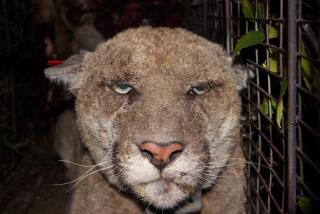Editorial: Coronavirus is teaching us lessons on how to coexist with nature
- Share via
Shut inside their homes day after day by the COVID-19 pandemic, people have been reveling in photos of wildlife roaming in the spaces they left behind. But the images don’t necessarily reveal what you think.
Those inspiring photos of dolphins supposedly returning to the newly boat-free canals of Venice, Italy? Actually, they were hundreds of miles away in Sardinia, in a spot where they’ve been known to show up. The elephants seen marching through a Chinese village? That’s real, but not an uncommon phenomenon. The same is true for the monkeys shown in cities of India, which have been so prevalent for years that they are generally seen as pests, not delights.
Still, there are signs that when humans decamp from the streets, wildlife expands its territory. Bobcats venture into suburban neighborhoods; coyotes are spotted in the streets of New York and near the Golden Gate Bridge. They were always in the area, but they’re a bit bolder without us and our cars to frighten them off. A mountain lion trotted in the deserted central streets of densely populated Santiago, Chile. Wild goats regularly visit a town in Wales. Wild boars have descended on Haifa, Israel; Barcelona, Spain; and other cities. A kangaroo hopped along a once-busy street in Adelaide, Australia, population 1.2 million.
It rekindles our spirits and gives us hope to think that, despite humanity’s near-relentless efforts to shove nature into ever-smaller corners, it rebounds effortlessly. We notice more birdsong around us; is that because the birds feel freer to make themselves known, or is it because we’ve finally shut up long enough to notice them? In any case, it’s a good feeling to sense that nature is so resilient, so all we have to do is turn our backs for a few weeks for it to see new life.
But that’s not really true either.
Some of these animals are unwelcome, even dangerous, in situations where they have to share space with people. Coyotes kill pets and wild boars carry disease, shove native wildlife out of their space and tear up agricultural fields. In New Orleans, empty streets and lack of restaurant scraps sent hordes of rats into the open, searching for food. Mountain lions and people cannot safely cohabit; we’d be less thrilled with their presence if they were regular visitors.
Meanwhile, things could go badly for highly endangered, iconic species such as elephants and rhinoceroses. Already, illegal hunting of rhinos for their valuable horns increased in Botswana as the economy crumbled. Safari tourism used to bring in the money and the human presence that kept poachers in check to some degree.
There are success stories as well. Wildlife scientists report endangered sea turtles hatching once again on Brazilian beaches. Closed national parks have given wildflowers and other flora a chance to grow untrampled and bears a chance to roam freely. Overfished seas are getting a rest, although it would require a year of respite for fish populations to make a serious comeback. Unmowed verges on the edges of farmland are providing habitat for threatened species of native bees — which don’t make honey but often are excellent pollinators.
Of course, humans aren’t going to stay shuttered in their houses forever just so that bobcats and quail can have a field day in their yards. But wildlife scientists say our new delight in nature can be carried over to the other side of the pandemic, if we want to keep the romance alive.
Wild animals’ willingness to venture into unnatural terrain is a sign that their current ranges are too small. Expansive bridges of open land from one wilderness zone to another would give them more of the room they need — and would keep them from becoming suburban pests. Pushing development further into the wildland interface isn’t the way to nurture nature.
If we lived with closed beaches this long, we can certainly close large stretches for the sake of sea turtle nesting season. If most fishing boats remained in dock for months with their crews continuing to receive federal relief, it should be possible to pay many of those workers to wait a year before heading out again. It’s easy to grow hedgerows around farms for native bees; for that matter, suburbanites could do the same if they weren’t determined to rake up every bit of leaf litter for that perfectly groomed look. National parks could consider rotating more visitor-free resting times for nature, or limiting entry, to keep the environment from being loved to death.
And we can always shut up and listen to the birds.
More to Read
A cure for the common opinion
Get thought-provoking perspectives with our weekly newsletter.
You may occasionally receive promotional content from the Los Angeles Times.










